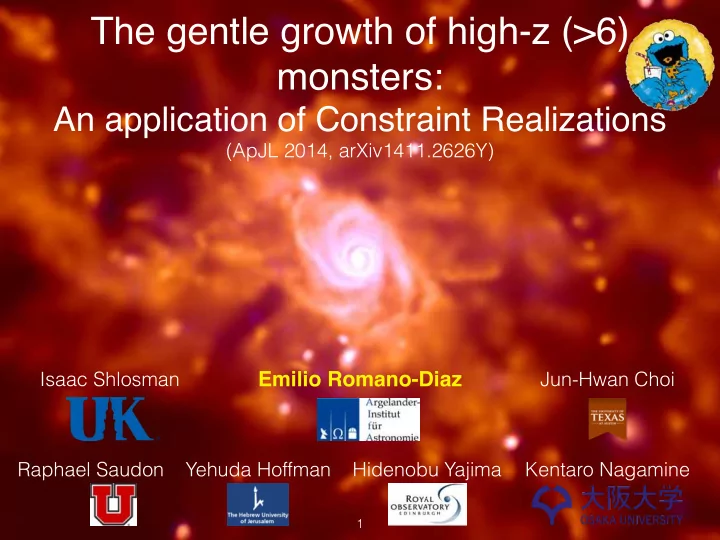

The gentle growth of high-z (>6) monsters: An application of Constraint Realizations (ApJL 2014, arXiv1411.2626Y) Emilio Romano-Diaz Isaac Shlosman Jun-Hwan Choi Raphael Saudon Yehuda Hoffman Hidenobu Yajima Kentaro Nagamine 1
Galaxy formation Spiral galaxies form via gas accretion (White & Rees 1978) + mergers = spherical systems (Toomre & Toomre 1972) Quiescent SF => disks Starburst are the result of mergers 2
Galaxy formation • Observations of Gunn-Peterson trough in QSO suggest reionization ended by z ~ 6. • Possible sources are high-z “normal” and dwarf galaxies which are very numerous and energetic enough to reionize the Universe (Stiavelli+04; Yan & Windhorst 04). • There are > 100 galaxies in 6.5 < z < 9 (Finkelstein+10; McLure+11; Bouwens+11; Lorenzoni+11; McCracken+12) • Galaxies even z~10!!! (?) (Bouwens+11) • Protocluster of galaxies z~8 (Trenti+12) 3
Galaxy formation • Discovery of QSOs z~6-8 => SMBH M~10 9 M ⊙ (Stiavelli+05,Kim+09,Maselli+09,Utsumi+10,Mortlock+11) => M DM ~10 12 M ⊙ => ρ co ~2.2±0.73 h 3 Gpc − 3 (Fan+04,Springel+05,Li+07,Overzier+09) => Formation clues ? (>60% mass from major mergers, Li+07 ) • Great diversity of environments (Kim+09, Utsumi+10, Trenti+12) • Recent high-z theoretical modeling indicate that major mergers are not the main mode of growth in galaxy formation nor responsible for the intense star formation (Dayal+13; Ryan+14) 4
Galaxy formation • Discovery of QSOs z~6-8 => SMBH M~10 9 M ⊙ (Stiavelli+05,Kim+09,Maselli+09,Utsumi+10,Mortlock+11) => M DM ~10 12 M ⊙ => ρ co ~2.2±0.73 h 3 Gpc − 3 (Fan+04,Springel+05,Li+07,Overzier+09) => Formation clues ? (>60% mass from major mergers, Li+07 ) • Great diversity of environments (Kim+09, Utsumi+10, Trenti+12) • Recent high-z theoretical modeling indicate that major mergers are not the main mode of growth in galaxy formation nor responsible for the intense star formation (Dayal+13; Ryan+14) 5
So, how do galaxies grow at high- z ? 6
How & where can we find such monsters? • Perform simulations in large volumes: (Millenium...) I.find your most attractive guy II.Check halo characteristics (virial quantities) III.Extrapolate back in time & resimulate at higher resolution or use Constrained Realizations (Bertschinger 86, Hoffman & Ribak 91) 7
Our approach • We compare the growth of galaxies in a high-density region against galaxies in a “normal” environment from z~6 up to z~14. • The growth is characterized by smooth accretion and mergers. • We use CR/UCR baryonic cosmological numerical simulations to address this issue. 8
Simulations: IC • CR formalism (Bertschinger 86, Hoffman & Ribak 91) • WMAP5 Cosmology: Ω M =0.234, Ω b =0.045, Ω Λ =0.721, h 0 =0.701, σ 8 =0.817 • Halo M ~ 10 12 M ⊙ /h • Collapse z ~ 6 9
Simulations • Gadget3: Nbody+SPH • SF: Pressure Model ρ SF =1.5X10 − 2 M ⊙ pc − 3 ( n H,SF =1cm − 3 ) (Schaye & dalla Vecchia 08, C&N 10) • Cooling: H, He, metals • Feedback: SNe, Winds (S&H 03, C&N11) • Multi-zoom (H-R baryons: CR: r ~ 3.5Mpc/h; UCR: r~7Mpc/h) • M => 4X10 5 M ⊙ (DM), 10 5 M ⊙ (gas), 5X10 4 M ⊙ (stars) • ε ~ 40 pc (physical) • 140 output files 10
11
12
Halos & Galaxies HOP group finder (Eisenstein & Hut 98) : ρ crit (z) Halo: DM-only & All matter (DM+gas+*) Galaxy : a baryonic HOP-defined isodensity region with 1) ρ cut = ρ 0.01SFT 2) M * > 3X10 7 M ⊙ (Ryan+14) => M DM > 2X10 8 M ⊙ Halos & galaxies traced back in time, merger history 13
Galaxies 14
Mergers 15
MAH: CR 16
MAH: UCR 17
Accretion Temperature: Metallicity: Mergers: A. Major: 1:3 A. Cold: (<3X10 4 ) A. Pristine: (10 -3 <) B. Intermediate: 4:10 B. Warm: [3X10 4 ,10 5 ] B. Supsolar: [10 -3 ,0.5] C. Minor: 10:… C. Hot: (>10 5 ) C. Solar: [0.5,1.1] • Smooth: Matter that does not belong D. Suprasolar: (>1.1) to any halo 18
Gas Accretion 19
Gas Accretion 20
Gas Accretion 1. Smooth acc. dominates 2. Minor & intermediate mergers 2nd largest cont. Independent of density environment 21
Stellar accretion 22
Stellar accretion 1. Local SF dominates growth 2. Major Mergers relevant earlier 23
Metallicity • Galaxies “well-defined” get most of gas semi-recycled • Supra-solar Z indication of intense SF in neighborhood • Minimal pristine Z accretion 24
vs Observations (RT) Luminosity Function mm detection 25 Yajima+14
Conclusions… (so far) • CR offer a unique laboratory to address peculiar environments (high-z) • Halos possibly precursors of QSO (z~6) harbor well defined gaseous & stellar disks. • Our simulated disk galaxies in the over-dense regions appear consistent with the presence of extended morphologies in bright z~7 galaxies observed by HST (Oesch+10, Ryan+14) • Halos (independent of M) host more than 1 galaxy • Galaxies (independently of mass) mostly grow via smooth gas accretion & in-situ SF • Mergers deposit more stellar material than gas content (this might be dependent on feedback mechanisms) • Most of the gas-accreted is cold and semi-recycled. • Small galaxies grow (as well) via smooth accretion, although they acquire more stellar content via mergers than the one formed in-situ. 26
future… • Cold vs hot accretion in Galaxies • the usual suspect: feedback -> AGN, early feedback… • Evolving U-V background… • Different SF mechanisms… 27
Recommend
More recommend